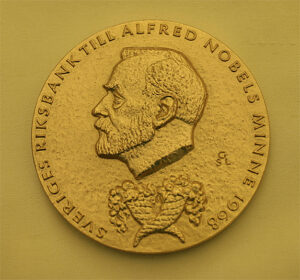
William S. Vickrey
1914-1996

William Vickrey and james mirrlees shared the 1996 Nobel Prize in economics “for their fundamental contributions to the economic theory of incentives under asymmetric information.”
One of the most important economic principles is that incentives affect people’s behavior. It is also true that government officials virtually never know as much about the people their policies affect as the people affected know about themselves. In economics, the fancy term for this fact is “asymmetric information.” How, then, does a government that is conscious of its ignorance set up incentives so that people will act in ways that are useful, not only to themselves but also to others? William Vickrey spent his career studying this issue, in areas ranging from income taxation to auction design to subway fares and highway tolls. In the process, he made some striking discoveries.
Consider income taxation. Vickrey, himself a strong believer in using the tax system to take from the rich and give to the poor, saw that such forced transfers would reduce people’s incentive to work. His 1964 textbook, Microstatics, was one of the first economics textbooks to take this issue seriously. He wrote:
There still remains the fact that money income from gainful work is subject to an income tax while imputed income from leisure is not taxed…. Accordingly, an income tax tends to make individuals choose leisure in preference to gainful work to an uneconomical extent. (p. 261)
For that reason, Vickrey favored fairly low marginal tax rates on high-income people. And what should the marginal tax rate on the highest-skilled person be? In 1987, Vickrey, drawing on work by Mirrlees, wrote:
A somewhat disturbing result is that if the distribution of skills has a known upper limit, the marginal tax rate should fall to zero at the top of the scale where there is only one taxpayer left, the argument being that there is no point to deterring him from earning the last dollar of income, since if he does not earn it there will be no revenue from it. (p. 1024)
Supply-side
economist Arthur Laffer could not have said it better.
Vickrey also did early work in the theory of sealed-bid auctions. He showed that a second-price auction, whereby the highest bidder gets the item but pays only the price bid by the second-highest bidder, causes the good to be allocated to the person who values it most. The reasoning is as follows. The highest bidder knows that he can bid the true value of the item to him because he will not have to pay that value if he wins. This gives him an incentive to bid what the item is truly worth. Every bidder has this same incentive. So every person ends up bidding the true value of the item to him, and the item thus goes to the person who values it most. Under the standard first-price auction, by contrast, the person who values the good most might underbid and actually bid less than someone who values it less. Second-price auctions are now called Vickrey auctions.
Tolls on roads and bridges were common in nineteenth-century America and were discussed in economics textbooks of the time. But that insight was lost to the modern era until Vickrey brought it back, showing that tolls that were higher during times of peak use would lessen congestion. Always an empirical as well as a theoretical economist, Vickrey gave the following reasoning about the tolls (in 1963 dollars) he advocated for Washington, D.C.:
It turned out that for each additional car making a daily trip that contributes to the dominant flow, during the peak hour, an additional investment of $23,000 was projected. In other words, a man who bought a $3,000 car for the purpose of driving downtown to work every day would be asking the community, in effect, to match his $3,000 investment with $23,000 from general highway funds. (Vickrey 1963, p. 456)
Vickrey’s solution—higher tolls at peak times—would have obviated the need for many new highway-widening projects because many drivers, faced with tolls that reflected the true cost of such projects, would instead use carpools or buses. Those left would enjoy relatively uncongested roads but would pay for them. Vickrey even suggested a futuristic technology that has become standard: “equipping all cars with an electronic identifier.” As early as 1948, Vickrey suggested pricing solutions for hotels and airlines that look a lot like the “yield management” that modern airlines practice.
Vickrey was born in Victoria, British Columbia, but moved to the United States at an early age. He earned his B.S. in mathematics from Yale in 1935, his M.A. in economics from Columbia University in 1937, and his Ph.D. in economics from Columbia in 1947. He spent his career as a professor at Columbia and died three days after winning the Nobel Prize.
About the Author
David R. Henderson is the editor of The Concise Encyclopedia of Economics. He is also an emeritus professor of economics with the Naval Postgraduate School and a research fellow with the Hoover Institution at Stanford University. He earned his Ph.D. in economics at UCLA.
Selected Works
